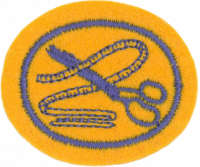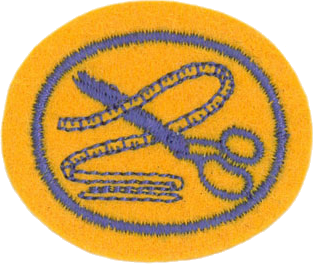Difference between revisions of "AY Honors/Tailoring/Answer Key/es"
From Pathfinder Wiki
(Created page with "</noinclude>") |
(Updating to match new version of source page) |
||
| (4 intermediate revisions by one other user not shown) | |||
| Line 1: | Line 1: | ||
| − | + | {{HonorSubpage}} | |
| − | |||
| − | {{ | ||
| − | |||
| − | |||
| − | |||
| − | |||
| − | |||
| − | |||
| − | |||
| − | }} | ||
| − | |||
| − | |||
| − | |||
<section begin="Body" /> | <section begin="Body" /> | ||
{{ansreq|page={{#titleparts:{{PAGENAME}}|2|1}}|num=1}} | {{ansreq|page={{#titleparts:{{PAGENAME}}|2|1}}|num=1}} | ||
| Line 174: | Line 161: | ||
{{ansreq|page={{#titleparts:{{PAGENAME}}|2|1}}|num=4}} | {{ansreq|page={{#titleparts:{{PAGENAME}}|2|1}}|num=4}} | ||
<noinclude></noinclude> | <noinclude></noinclude> | ||
| − | <!-- 4. | + | <!-- 4. Mencionar los puntos a tenerse en cuenta cuando se hace una prenda de vestir a la medida y que tenga un buen acabado. --> |
| − | |||
{{clear}} | {{clear}} | ||
| Line 185: | Line 171: | ||
{{ansreq|page={{#titleparts:{{PAGENAME}}|2|1}}|num=5}} | {{ansreq|page={{#titleparts:{{PAGENAME}}|2|1}}|num=5}} | ||
<noinclude></noinclude> | <noinclude></noinclude> | ||
| − | <!-- 5. | + | <!-- 5. Estar familiarizado con los siguientes equipos de planchar: --> |
| − | + | {{clear}} | |
<noinclude></noinclude> | <noinclude></noinclude> | ||
{{ansreq|page={{#titleparts:{{PAGENAME}}|2|1}}|num=5a}} <!--T:51--> | {{ansreq|page={{#titleparts:{{PAGENAME}}|2|1}}|num=5a}} <!--T:51--> | ||
<noinclude></noinclude> | <noinclude></noinclude> | ||
| − | |||
| − | {{ | + | {{clear}} |
<noinclude></noinclude> | <noinclude></noinclude> | ||
| Line 201: | Line 186: | ||
<noinclude></noinclude> | <noinclude></noinclude> | ||
| − | |||
| − | |||
| − | |||
<noinclude></noinclude> | <noinclude></noinclude> | ||
{{CloseReq}} <!-- 5b --> | {{CloseReq}} <!-- 5b --> | ||
{{ansreq|page={{#titleparts:{{PAGENAME}}|2|1}}|num=5c}} <!--T:54--> | {{ansreq|page={{#titleparts:{{PAGENAME}}|2|1}}|num=5c}} <!--T:54--> | ||
<noinclude></noinclude> | <noinclude></noinclude> | ||
| − | |||
<noinclude></noinclude> | <noinclude></noinclude> | ||
| Line 214: | Line 195: | ||
{{ansreq|page={{#titleparts:{{PAGENAME}}|2|1}}|num=5d}} <!--T:55--> | {{ansreq|page={{#titleparts:{{PAGENAME}}|2|1}}|num=5d}} <!--T:55--> | ||
<noinclude></noinclude> | <noinclude></noinclude> | ||
| − | |||
| − | + | {{clear}} | |
<noinclude></noinclude> | <noinclude></noinclude> | ||
| Line 223: | Line 203: | ||
<noinclude></noinclude> | <noinclude></noinclude> | ||
| − | + | {{clear}} | |
| − | |||
| − | {{ | + | {{clear}} |
<noinclude></noinclude> | <noinclude></noinclude> | ||
| Line 232: | Line 211: | ||
{{ansreq|page={{#titleparts:{{PAGENAME}}|2|1}}|num=5f}} <!--T:60--> | {{ansreq|page={{#titleparts:{{PAGENAME}}|2|1}}|num=5f}} <!--T:60--> | ||
<noinclude></noinclude> | <noinclude></noinclude> | ||
| − | |||
| − | + | {{clear}} | |
<noinclude></noinclude> | <noinclude></noinclude> | ||
| Line 241: | Line 219: | ||
{{ansreq|page={{#titleparts:{{PAGENAME}}|2|1}}|num=6}} | {{ansreq|page={{#titleparts:{{PAGENAME}}|2|1}}|num=6}} | ||
<noinclude></noinclude> | <noinclude></noinclude> | ||
| − | <!-- 6. | + | <!-- 6. Saber por lo menos dos métodos para hacer ojales para botones. Hacer un ojal para botón usando uno de estos métodos. --> |
| − | + | {{clear}} | |
| − | |||
| − | {{ | ||
| − | + | {{clear}} | |
<noinclude></noinclude> | <noinclude></noinclude> | ||
| Line 253: | Line 229: | ||
{{ansreq|page={{#titleparts:{{PAGENAME}}|2|1}}|num=7}} | {{ansreq|page={{#titleparts:{{PAGENAME}}|2|1}}|num=7}} | ||
<noinclude></noinclude> | <noinclude></noinclude> | ||
| − | <!-- 7. | + | <!-- 7. Hacer un bolsillo de ojal de sastre o un bolsillo de plastrón con ojal. --> |
| − | + | {{clear}} | |
| − | {{ | + | {{clear}} |
| − | + | {{clear}} | |
| − | {{ | + | {{clear}} |
<noinclude></noinclude> | <noinclude></noinclude> | ||
| Line 267: | Line 243: | ||
{{ansreq|page={{#titleparts:{{PAGENAME}}|2|1}}|num=8}} | {{ansreq|page={{#titleparts:{{PAGENAME}}|2|1}}|num=8}} | ||
<noinclude></noinclude> | <noinclude></noinclude> | ||
| − | <!-- 8. | + | <!-- 8. Demostrar su habilidad en confección de un traje para un hombre o una mujer que sea a su medida. --> |
| − | + | {{clear}} | |
<noinclude></noinclude> | <noinclude></noinclude> | ||
{{CloseReq}} <!-- 8 --> | {{CloseReq}} <!-- 8 --> | ||
<noinclude></noinclude> | <noinclude></noinclude> | ||
| − | == | + | ==Referencias== |
<noinclude></noinclude> | <noinclude></noinclude> | ||
| − | + | {{CloseHonorPage}} | |
| − | |||
Latest revision as of 00:18, 15 July 2022
1
Identificar los siguientes materiales:
1a
Lana
1b
Lana planchada (estambre)
1c
Algodón
1d
Lino
1e
Seda
1f
Seda artificial
1g
Rayón
1h
Poliéster
1i
Lana sintética
2
Identificar tres de los siguientes tejidos:
2a
Liso/plana
2b
Tejido de esterilla (tipo cesta)
2c
Tipo listones
2d
Sarga
2e
Tipo cruzado
2f
Tejido de pelillos
3
¿Cómo se utilizan los siguientes materiales?
3a
Capa intermedia
3b
Hilvanado de sastre
3c
Lona de sastre u otro tipo de tela de relleno
3d
Costura de relleno
3e
Relleno que se pega con la plancha
4
Mencionar los puntos a tenerse en cuenta cuando se hace una prenda de vestir a la medida y que tenga un buen acabado.
5
Estar familiarizado con los siguientes equipos de planchar:
5a
Tabla de manga
5b
Guante de presión
5c
Rodillo de sastre
5d
Cojín de sastre
5e
Tabla de sastre
5f
Tabla de agujas
6
Saber por lo menos dos métodos para hacer ojales para botones. Hacer un ojal para botón usando uno de estos métodos.
7
Hacer un bolsillo de ojal de sastre o un bolsillo de plastrón con ojal.
8
Demostrar su habilidad en confección de un traje para un hombre o una mujer que sea a su medida.


